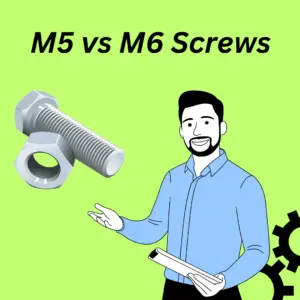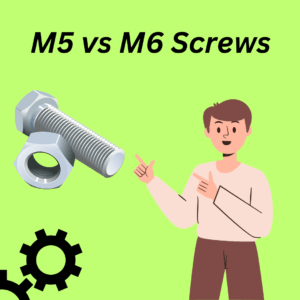Introduction
When it comes to DIY projects, furniture assembly, or general construction work, having the right screws is crucial. Two commonly used screw sizes are M5 and M6 screws. While they may seem similar, there are key differences that make them suitable for specific applications. In this article, we’ll dive into the characteristics of M5 and M6 screws, their uses, and help you determine which one is the right fit for your project.
Understanding Screw Sizes and Measurements
Before we delve into the specifics of M5 and M6 screws, it’s essential to understand screw sizes and measurements. Screws are typically categorized based on their diameter, thread pitch, and length. The diameter is denoted by a metric size, such as M5 or M6, followed by a number. The thread pitch refers to the number of threads per millimeter. For example, an M5 screw with a pitch of 0.8 means it has 0.8 threads per millimeter.

M5 Screws: Versatile and Reliable
Overview of M5 Screws
M5 screws are a popular choice due to their versatility and widespread availability. They have a smaller diameter compared to M6 screws, making them suitable for various applications where a slimmer profile is desired.
Common Uses of M5 Screws
M5 screws find applications in numerous industries and projects, including:
1. Electronics: M5 screws are commonly used in electronics assembly, securing components, and mounting circuit boards.
2. Small-scale woodworking: These screws are ideal for joining lightweight materials, such as particleboard, MDF, or plywood.
3. Automotive industry: M5 screws are often used in automotive interiors, such as securing dashboard components or attaching panels.
4. Furniture assembly: M5 screws are frequently employed in furniture assembly, particularly for attaching hinges, drawer slides, and other hardware.
5. 3D printing: M5 screws are utilized in 3D printers to secure parts and components together.
M6 Screws: Sturdy and Heavy-duty
Overview of M6 Screws
M6 screws have a larger diameter compared to M5 screws, making them stronger and more suitable for heavy-duty applications that require additional stability and load-bearing capabilities.
Common Uses of M6 Screws
M6 screws are commonly found in the following applications:
1. Construction projects: M6 screws are widely used in construction for securing structural elements and heavy timber connections.
2. Industrial machinery: These screws are essential for assembling heavy machinery and equipment that require strong fasteners.
3. Metal fabrication: M6 screws are commonly utilized in metal fabrication projects due to their durability and ability to withstand high levels of stress.
4. Outdoor furniture and fixtures: M6 screws are an excellent choice for outdoor furniture, garden structures, and other fixtures that require weather resistance and robust fastening.
Choosing the Right Screw Size for Your Project
When deciding between M5 and M6 screws, there are a few factors to consider:
1. Application requirements: Assess the specific needs of your project. Consider the weight, load-bearing capacity, and material compatibility to determine which screw size is most suitable.
2. Screw strength: If your project involves heavy-duty applications or requires a higher level of stability, M6 screws are the better choice due to their larger diameter and increased strength.
3. Space limitations: If space is limited or a slimmer profile is desired, M5 screws are more appropriate due to their smaller diameter.
4. Availability and cost: M5 screws are generally more readily available and cost-effective compared to M6 screws, which may be a consideration depending on your project budget.
Conclusion
In summary, both M5 and M6 screws have their distinct advantages and applications. M5 screws are versatile, commonly used in electronics, woodworking, and furniture assembly. On the other hand, M6 screws offer greater strength and are suitable for heavy-duty construction, metal fabrication, and outdoor projects. By considering the specific requirements of your project, you can choose the right screw size to ensure secure and reliable fastening.

FAQs
Q1: Can I use M5 screws in place of M6 screws?
A1: It’s generally not recommended to substitute M5 screws for M6 screws or vice versa, as they have different diameters and strength capacities. It’s best to use the appropriate screw size for the intended application.
Q2: Are M5 and M6 screws interchangeable?
A2: While M5 and M6 screws cannot be directly interchanged due to their size differences, adapters or inserts may be available to convert a hole or thread from one size to another.
Q3: How do I measure the diameter of a screw?
A3: To measure the diameter of a screw, use a caliper or a screw gauge to determine the width of the threaded portion. This measurement will help identify the appropriate screw size.
Q4: Are M5 and M6 screws metric or imperial?
A4: M5 and M6 screws are metric screws. The “M” denotes metric, followed by the size and thread pitch.
Q5: Where can I purchase M5 and M6 screws?
A5: M5 and M6 screws are widely available at hardware stores, home improvement centers, and online retailers. Make sure to check for the specific size, length, and thread pitch required for your project.
Watch this one,
Video Credits – Hacks by Dad
You May Also Like
-
27 x 1 1/4 Inner Tube Equivalent: Finding the Right Fit for Your Bike
-
A Beginner’s Guide to Thumb Shifters on Drop Bars: Gear Up for Smooth Cycling!



